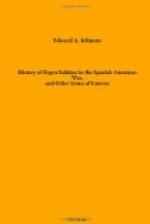The Y.M.C.A. tent is a great blessing to the regiment, and is very popular, and aids in every possible way the work of Chaplain Durham.
The way Col. Young manages the canteen cannot be too highly recommended. Ordinarily the term canteen is another name for a drinking saloon, though a great variety of articles, such as soldiers need, are on sale and the profits go to the soldiers. But the canteen of the Third North Carolina is a dry one. By that I mean that spiritous or malt liquors are not sold. Col. Young puts into practice the principles that have always characterized his personal habits, and with the best results to his regiment.
I had the pleasure of meeting Capt. S. Babcock, Assistant Adjutant General of the Brigade, who has known this regiment since it was mustered into the service. He speaks of it in the highest terms. I also met Major John A. Logan, the Provost Marshal, and had a long interview with him. He said the Third North Carolina was a well-behaved regiment and that he had not arrested a larger per cent of men from this regiment than from any other regiment, and that I was at liberty to publicly use this statement.
While in the sleeper on my way home I fell in with Capt. J.C. Gresham, of the Seventh Cavalry. Capt. Gresham is a native of Virginia, a graduate of Richmond College and West Point, and has served many years in the regular army. He was with Colonel Forsyth in the battle with the Sioux at Wounded Knee, South Dakota. I had met him previously, when I was in the United States Indian service in Kansas. He informed me that he mustered in the first four companies of the Third North Carolina, and the Colonel and his staff, and that he had never met a more capable man than Colonel Young.
The Third North Carolina has never seen active service at the front, and, as the Hispano-American war is practically a closed chapter, it will probably be mustered out of the service without any knowledge of actual warfare. I thought, however, as I stood on the dry goods box and gave them kindly advice, and looked down along the line, that if I was a soldier in a white regiment and was pitted against them, my regiment would have to do some mighty lively work to “clean them out.”
CHARLES FRANCIS MESERVE.
Shaw University,
Raleigh, N.C., Jan. 25, 1899.
[Illustration: MR. JUDSON W. LYONS, REGISTER OF THE TREASURY, AND SIGNS U.S. “GREENBACKS” TO MAKE THEM GOOD.]
CHAPTER VIII.
GENERAL ITEMS OF INTEREST TO THE RACE,
John C. Dancy, re-appointed Collector of Port Wilmington, N.C. Salary $3,000.
The appointment of Prof. Richard T. Greener, of New York, as Consul to Vladivistock.
Hon. H.P. Cheatham, appointed as Register of Deeds of the District of Columbia. Salary $4,000.
Hon. George H. White elected to Congress from the Second Congressional District of North Carolina, the only colored Representative in that body.




